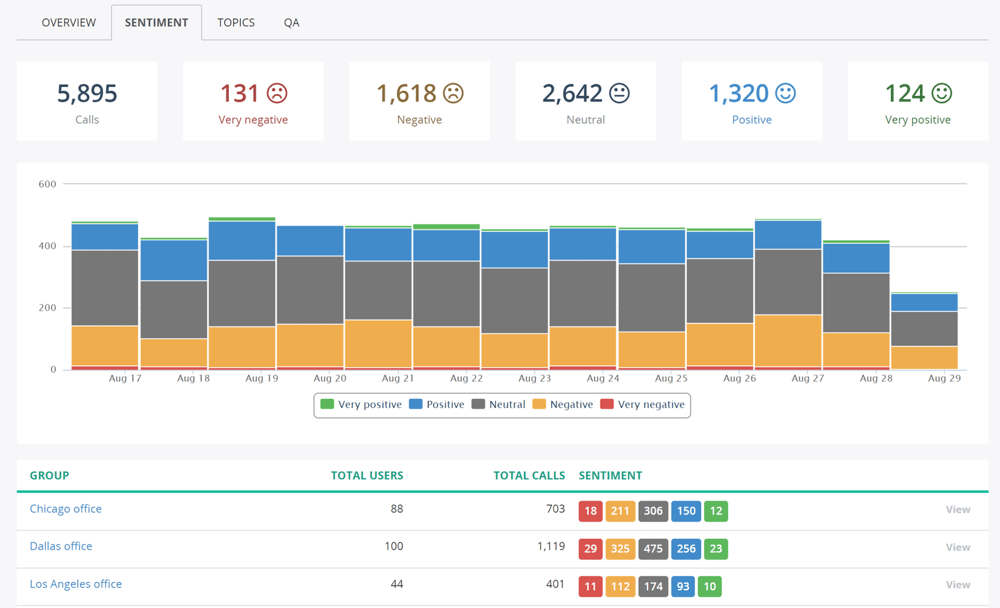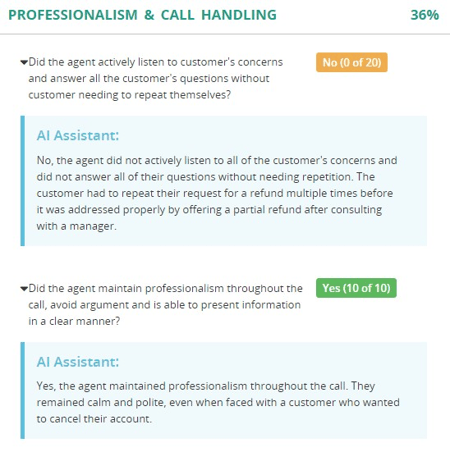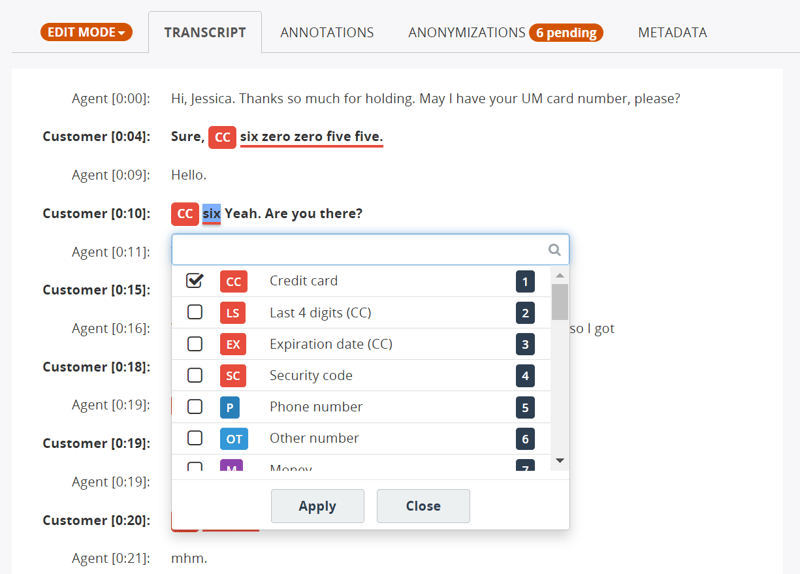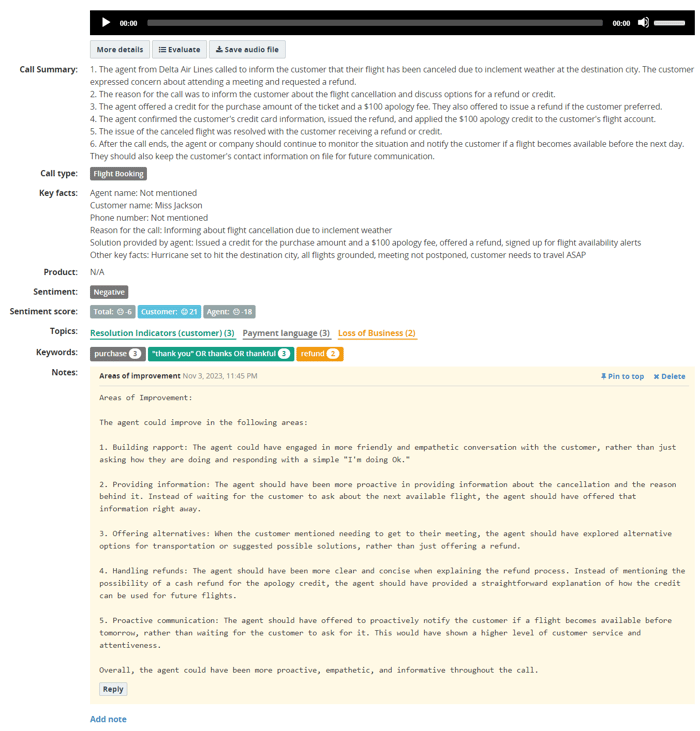- Chapter I: Introduction
- Chapter II: What is a Contact Center Conversation Intelligence Platform?
- Chapter III: AI-Driven Voice Analytics: The Heart of Conversation Intelligence
- Chapter IV: Generative AI-based Automated Quality Management (Auto QA)
- Chapter V Automated Data Redaction
- Chapter VI AI-Powered Agent Assist
- Chapter VII Additional Considerations
- Chapter VIII Conclusion
Introduction
Customers now expect outstanding service quality, personalized and relevant experiences, and high levels of digitalization when interacting with contact centers. Those contact centers that rise to the challenge are transforming themselves from a cost center to a revenue driver, actively contributing to the bottom line by:
- Automating Workflows,
- Creating an outstanding customer experience,
- Significantly increasing security and compliance,
- Drastically boosting efficiency and performance, and
- Driving Digital Transformation.
They achieve these five major goals and meet the demands of their customers and the expectations of their executive management with the help of a modern Conversation Intelligence Platform consisting of AI-powered Voice Analytics and Automated Quality Management solutions. This platform must:
- Be highly secure and compliant,
- Integrate with existing infrastructure natively,
- Require a low technology footprint,
- Be compatible with widely used enterprise-ready communication solutions,
- Drive maximum productivity and efficiency, and
- Be suitable for entirely on-site, completely remote, or hybrid setup, and
- Have sophisticated (AI-driven) Voice Analytics capabilities to extract insights from the massive amount of call recording data gathered.
But there are so many options out there. Some are suited better for some scenarios than others. How do you make sure you choose the solution that is right for you?
How To Choose A Conversation Intelligence Platform: Building Your Evaluation Criteria Checklist
In this guide, we have compiled more than a dozen years of industry expertise and lessons learned from helping hundreds of contact centers choose the right platform for them, even if that wasn’t MiaRec.
Before you dive in, we recommend that you determine who the primary stakeholders are for this initiative. This could include contact center managers, compliance officers, data analysts, and IT professionals. Together, start by outlining your organization's specific goals and objectives for implementing a Conversation Intelligence solution. What do you aim to achieve? Identify the key needs and challenges that the solution should address. Consider factors like improving customer experiences, enhancing agent performance, or ensuring compliance.
By doing so, you know what you want and need, which will be instrumental in finding a solution that will meet this gap.
Please note: Use the navigation on top to toggle between chapters. The sidebar will provide you with additional resources related to each chapter.
Download The Offline Version
Too much to read now? Download the offline, printer-friendly version of this buyer's guide now and read it later.
What is a Contact Center Conversation Intelligence Platform?
Data and analytics are pivotal in creating remarkable customer interactions. By leveraging the power of data-driven insights, businesses can gain a valuable understanding of customer preferences, behaviors, and needs. This knowledge empowers them to deliver personalized experiences, anticipate customer demands, and provide proactive support, all leading to increased satisfaction and loyalty.
The contact center is one of the most abundant sources of data an organization has at its disposal. The challenge is to make it usable in ways that you can analyze, collate, and turn into insights.
Modern contact centers are dealing with hundreds or even thousands of customers a day. To cope with this enormous workload and to be able to turn data into insights en masse, they have to be as efficient as possible.
They have to deploy smart workflows and automation wherever possible. For example, instead of manually evaluating 5% of your calls for agent performance, you should utilize AI to score 100% of your calls and then automatically determine the tiny fraction of calls that require human intervention.
This is where an AI-powered Conversation Intelligence Platform comes in.
What is a Conversation Intelligence Platform? [Definition]
Conversation Intelligence Platforms refer to technology solutions designed to analyze voice conversations between businesses and their customers and turn this data into actionable insights.
They achieve this by using generative AI, Large Language Models (LLMs), Machine Learning (ML), and advanced analytics. The objective is to transcribe, analyze, and convert conversations into structured data to extract valuable insights and leverage the power of AI technology to automate processes. This enables businesses to improve sales, customer service, and overall communication strategies.
Core Functions of a Conversation Intelligence Platform
-
Capture & Transcribe: Conversation Intelligence Platforms capture and transcribe call recordings.
-
Analyze: Using generative Artificial Intelligence (AI), Large Language Models (LLMs), and Machine Learning (ML), the platform analyzes the transcript to spot keywords, detect sentiment, and identify patterns (e.g., common customer pain points) within the conversations.
-
Provide Insights: Beyond just analysis, these platforms offer actionable insights. For instance, they might highlight best practices from top-performing sales representatives or identify areas where customer service agents need additional training.
-
Enhance Training & Performance: By understanding what works and what doesn't in customer interactions, businesses can better train their teams, ensuring that they communicate effectively and address customer needs efficiently.
-
Improve Compliance: Conversation Intelligence platforms help to increase compliance by identifying and automatically redacting personal information, such as credit card or social security numbers. They also can help verify whether or not agents read compliance statements and such.
-
Automate Workflows: Conversation Intelligence platforms exponentially increase the efficiencies of contact centers as they automate smart workflows, e.g., automatically scoring agents' calls, automatically identifying and redacting sensitive personal information or creating structured call summaries.
In essence, Conversation Intelligence Platforms empower businesses to transform every conversation into a learning opportunity, driving better decision-making, enhancing customer experiences, and optimizing various business operations.
Key Components
A Contact Center Conversation Intelligence Platform consists of an AI-driven Voice Analytics component that builds the foundation for transcribing, analyzing, and extracting data insights from call recording. Advanced platforms will provide generative AI-powered Automated Quality Management (Auto QA), Auto Data Redaction, and agent-assistant functionality, such as call summaries.
- AI-driven Voice Analytics:
- Speech-to-Text Transcription
- Automatic Keyword Extraction & Keyword Spotting
- Topical Analysis
- Sentiment Analysis
- Generative AI-based Automated Quality Management (Auto QA)
- AI-powered Automated Data Redaction
- AI-based Agent Assist (Call Summary, Key Facts, Entities, Call Categorization and Agent Feedback)
We will go through each segment in detail below.
"Highly impressed by MiaRec's expertise in very quickly installing their solution and beginning to record calls immediately. The process was very painless relative to a project of this scale. MiaRec has a highly intuitive interface that enabled us to expand the group of associates who can listen to recorded calls.
New users were provided access and were off and running without any need for further training. As the only source containing all our customer calls, we have been able to use MiaRec to very quickly find and listen to any calls that require review."
Jim L.
Director of Contact Centers - Large US Retailer
Download The Offline Version
Too much to read now? Download the offline, printer-friendly version of this buyer's guide now and read it later.
AI-Driven Voice Analytics: The Heart of Conversation Intelligence
With the advancements in speech recognition and Natural Language Processing (NLP) through Machine Learning (ML) and Artificial Intelligence (AI), accurately transcribing large volumes of audio files and extracting valuable and actionable Voice of Customer insights is now easily achievable. This breakthrough enables call recording data to be accessible, organized, and analyzable — effectively humanizing the call data.
While Voice Analytics is included in some contact center solutions, it is still a relatively new market with a wide range of features and capabilities that are not yet standardized or as widely adopted as call recording, compliance, and quality management solutions.
In the following sections, we will dive into each key component and provide insights on what to consider when evaluating Voice Analytics solutions.
What is Voice Analytics?
Voice Analytics, often also referred to as Speech Analytics, refers to the AI-driven topical keyword extraction and analytics of transcribed call recordings. It is worth noting that solutions that analyze the transcription (what is being said) are more accurate than solutions that analyze the tonality (how something is being said).
- Speech-to-Text Transcription
- Automatic Keyword Extraction & Keyword Spotting
- Topic Analysis & Categorization
- Sentiment Analysis
- Trend Analysis & Reporting
1. Speech-to-Text Transcription
As described below, speech-to-text transcription is the foundation on which Voice Analytics stands. Therefore, the first quality marker — one of the most important — is how good the speech recognition and Natural Language Processing (NLP) engine is. While there are amazing NLP engines available on the market, their high cost is a prohibitive factor for many organizations. Therefore, most vendors have opted to create their own.
Ask questions that allow you to gauge the quality of the transcription. For example, inquire about the current accuracy rate and how well it handles accents. Ask if there are any limitations you should know about, e.g., the number of minutes transcribed per month. Is there a product roadmap that maps out planned improvements over the next 12-24 months? Keep in mind, however, that there will be a point where the quality of the NLP is good enough for what you need, so don't get too carried away. Otherwise, you will have to make a trade-off between accuracy and affordability.
Image: This screenshot shows the Voice Analytics tab within the call details in MiaRec. The contact center manager can immediately see that this call involved went very well both on the agent and the customer side and that it was about a purchase.
2. Automatic Keyword Extraction & Keyword Spotting
While having transcripts is fantastic (reading transcripts can be done twice as fast as listening to audio), being able to extract keywords from those transcripts automatically is where it becomes interesting for contact centers due to the large number of calls they deal with every day. Look for a solution that allows you to easily create and enhance your own list of keywords and key phrases.
For example, keywords and phrases like "Ahem," "Let me check," "I have to look," "Let me ask my colleague," and others show agent insecurity. You can add competitor names (and their product names), your product and campaign names (to measure the effectiveness of a new product launch or marketing campaign), and so much more. The sky is the limit here, so easy administration is key!
Another nice feature is the ability to color code keywords. For example, anything related to shipping problems could be marked orange, refund/product returns/replacement requests could be marked red, and positive feedback or referrals could be marked in green. Color coding allows you to easily spot how a call progressed (bad to good, good to bad) as you look at the highlighted keywords in the transcript.
3. Topic Analysis & Categorization
Now that the keywords are automatically extracted, it is time to aggregate them into groups and categorize calls by topics, which could be anything from a reason for the call (e.g., refund request) to the next steps (e.g., flagged for follow-up). The so-called Topic Analysis categorizes conversations into relevant topics.
By doing this, you can analyze call volume and topic trends over time. (For example, you are getting twice as many calls about shipping issues this week, but why?) You can also search for all calls related to a certain topic.
Choose a solution that allows you to customize topic categories for in-depth analysis. Highly customizable topics allow you to define the topics that matter most to your business and align with your organization's specific needs. Watch out! Some vendors will offer "pre-canned topics solutions" that may have built-in topics that are not customizable and have limited utility for your company. Instead, look for a highly flexible solution that will adapt to your needs.
Secondly, choose a solution that allows you to set up and manage topics in an easy, yet controlled fashion. Topics should be seen as living, breathing things that should be constantly improved upon and fine-tuned.
Finally, explore how topics are used in a reporting context.
- Can you visually see a trend over time?
- Within the context of a single call, can you drill down — even to a granular level — to obtain further details?
- Are the topics highlighted? Do they show the associated keywords in the transcript?
- Are they color-coded so it is easy to detect which segment of the call they correlate with visually?
Image: This screenshot shows the number of calls and the call minutes analyzed based on specific topics in MiaRec's topic overview screen. As you can see, the most commonly analyzed topic was Resolution Indicators with 150 calls and 301 minutes.
4. Sentiment Analysis
Customer and agent sentiment analysis is extremely useful in evaluating the performance of a single agent, an entire team, or your overall call center as it lets you gauge how both the customer and the agent feel (positive, negative, or neutral) about the conversation they just had.

Image: This screenshot shows the sentiment analysis screen. Here, you can get an instant feel for what is going on in your customer base and how it changes over time. While there aren't many very positive or negative calls, the majority of those calls were negative or neutral.
The most common approaches are lexicon/rule-based (for basic sentiment categorization), pitch/tonality-type assessments, and machine learning (ML) based sentiment analysis.
- Lexicon- or rule-based sentiment analysis requires you to set up a catalog of keywords and phrases that the algorithm is looking for. However, it is limited to the words you entered, which makes it less reliable. In addition, you need a data engineer to use the expression syntax.
- Many vendors use simple indicators like voice pitch and volume to determine sentiment. But this can often lead to inaccurate results because people can be just as excited (and loud) about something positive as they can be about something negative.
- Machine Learning-based sentiment analysis is the most technologically advanced method of determining sentiment. It is also the most accurate, nuanced, and reliable.
We recommend, therefore, that you opt for a Machine Learning approach.
5. Trend Analysis & Reporting
Reporting capabilities are essential for Voice Analytics. Supervisors should be able to easily and quickly analyze call volume trends per topic over time, e.g., changes in the number of calls related to product returns, shipping problems, and upgrade opportunities from last month to this month. This includes the total number of calls and a trend diagram for each topic for the selected period (days, weeks, months, quarters, or years).
It is a good idea to play around with the reporting and dashboarding to see what you can report on. Can you report on the number of calls containing competitor names or how many times certain key phrases were used? Can you create automatic alerts and notifications should a certain threshold be exceeded? Can you set up recurring reports to be sent out automatically on a particular weekday?
Image: This screenshot gives you a glance into the usefulness of MiaRec reporting. Here you can see the call sentiment across locations or groups. You can get deeper insights in your topics and call volume as well.
"MiaRec allows us to simply and quickly record our agents, listen in real-time to live calls, and lightly integrate targeted search for call recordings from our CRM. We’ve been using it for years, and it has improved and grown over time to become a workhorse in our QA and compliance flows."

Paul McGurn
Telecommunications Architect - LogMeIn
Generative AI-based Automated Quality Management (Auto QA)
Traditionally, quality assurance in contact centers involved manual evaluations of a small subset of calls to improve adherence to standards and best practices. However, manual evaluations can be labor-intensive and time-consuming, and may only cover a limited percentage (usually 2-5%) of interactions.
Three Approaches to Quality Management
Traditionally, manual QA tools were the most suitable tool for a very small contact center (up to 5 agents), but with the advances of AI, even tiny contact centers can achieve a positive AI from Auto QA. However, manual quality management solutions still play a key role in organizations with highly complex performance criteria. But rather than solely relying on manual evaluation, contact centers use hybrid scenarios where Auto QA automatically scores 100% of their calls and then automatically identifies those that need human evaluation.
To solve this issue, keyword-based automated quality management solutions were developed. The Machine Learning algorithm parses through a transcript looking for pre-set keywords and phrases that can help determine how the agent performed. For example, to answer the question “Did the agent say their name?” the solution will look for the agent saying “My name is…” or “This is…”.
However, these solutions are cumbersome to set up and maintain and are relatively unreliable as they cannot understand the context of a conversation. This is where Generative AI-based Automated Quality Assurance (Auto QA) comes in. Auto QA refers to using advanced technologies, particularly Generative AI, to automatically assess and ensure the quality of customer interactions in contact centers.
Additional Resources
Generative AI-based Auto QA aims to overcome these limitations by automating the process, allowing for a more comprehensive and efficient assessment of interactions.
- AI-Powered Analysis: Auto QA is based on Large Language Models that have been trained on thousands of calls. This extensive training allows generative AI to analyze and evaluate interactions with a high degree of accuracy.
- Comprehensive Coverage: Unlike manual evaluations that might cover a small fraction of interactions, the AI-powered solution offers visibility into 100% of interactions, ensuring a more thorough quality assurance process.
- Unparalleled Accuracy: Auto QA surpasses traditional methods that rely on predefined keywords and key phrases. Generative AI allows for a deeper understanding of customer interactions, resulting in higher accuracy levels.
- Context Understanding: The AI comprehends the intricacies of call conversations and captures the context within which they occur. This means it can provide meaningful insights even in conversations with varied phrasing that couldn't be predicted in advance.
- Zero Configuration: The system comes ready to use, eliminating the need for extensive setup or configuration. This user-friendliness extends to the point where there's no need for data analysts or AI engineers to operate it.
- Integration with Other Analytical Tools: Auto QA integrates seamlessly with Sentiment Analysis and Topical Analysis, enriching the depth of insights obtained from conversations.
If you're considering implementing an Automated Quality Assurance solution, it's essential to understand both its advantages and limitations. MiaRec's Auto QA offers unparalleled accuracy, context understanding, and comprehensive coverage. It's crucial to assess if these features align with your contact center's specific needs. Always consider your unique requirements, budget, and existing infrastructure before deciding.

Image: The screenshot above shows an automatically performed call evaluation by the generative AI powered Auto QA feature based on the contact center's call evaluation criteria.
If you do decide that a generative AI-based Quality Assurance solution is right for you, we recommend that you look for a Conversation Intelligence platform that is flexible and will allow you to combine both manual and automated approaches for the best results possible.
We needed a platform that went beyond basic interaction recording. We wanted a single solution that would provide usable customer service insight. We needed analytics tools to measure performance and customer sentiment. Most of all, the data had to be organized, easily accessed, and easy to understand without having to become experts in analytics."

Jared Jenevein
IT Analyst - Companions & Homemakers
Automated Data Redaction
Data redaction is paramount in ensuring the protection of sensitive customer information and maintaining trust. As contact centers often handle vast amounts of personal and confidential data, including financial details, health records, and other Personally Identifiable Information (PII), it's essential to mask or remove this data to prevent potential misuse or breaches.
Implementing data redaction not only safeguards customers' privacy but also helps contact centers comply with strict data protection regulations, thereby avoiding legal repercussions, and upholding their reputation in the industry.
There are three primary automated data redaction methods:
- Numeric Data Redaction focuses on masking or altering numerical values, like credit card or social security numbers. Specific digits are replaced with placeholders to safeguard sensitive details. While this approach is mainly direct and straightforward for numerical data, it comes with a number of disadvantages. For example, it can lead to over-redaction, mistakenly masking non-PII data like customer account numbers, which diminishes the data's analytical value. It's also ineffective for non-numeric entities such as names or brand names.
- Pattern-Matching Data Redaction uses predefined patterns and manually set rules to identify and mask sensitive data. Automated tools process call transcripts, searching for sequences matching these patterns, and triggering redaction when a match is found. This can be tailored to specific organizational needs and is effective with proper configuration, but it requires significant upfront manual configuration. In addition, pattern-matching data redaction is notorious for over- and under-redaction, so consistent and extensive auditing is necessary.
- Machine Learning-Based Data Redaction is the most technically advanced method as it utilizes Machine Learning (ML), a subset of Artificial Intelligence (AI). Instead of relying on manual rules, ML models improve with experience, becoming more accurate as they analyze more data. They can discern context, differentiate between similar data types, and recognize new terms. Named Entity Recognition (NER), an ML-based Natural Language Processing technique, is particularly effective in extracting a wide range of Personally Identifiable Information (PII) from unstructured texts.
ML/NER-based data redaction is not only automatic — which means it is much more scalable as it requires no manual labor — but is also highly accurate as it has a deep contextual understanding and can therefore identify sensitive data much more reliably. It also adapts and improves over time, making it the most effective auto data redaction method available today. It is worth noting that while the most common data redaction scenarios (e.g., redacting payment card details for PCI-DSS compliance) are covered right out of the box, you might need to train your own custom Large Language Model for other use cases, e.g., recognizing and redacting patient information.

Image: The above screenshot shows MiaRec's ML/NER-based data redaction feature called Auto Redaction.
In conclusion, while each method has its strengths, it's crucial to choose the one that best aligns with an organization's specific needs and the data being handled.
We needed a platform that went beyond basic interaction recording. We wanted a single solution that would provide usable customer service insight. We needed analytics tools to measure performance and customer sentiment. Most of all, the data had to be organized, easily accessed, and easy to understand without having to become experts in analytics."

Jared Jenevein
IT Analyst - Companions & Homemakers
AI-Powered Agent Assist
Since the rise of generative AI, Conversation Intelligence solution providers are trying to figure out how to utilize this new technology to benefit contact centers. Most vendors offer AI-powered Call Summary features, but over the next months and years, this will be where the most innovation happens. We will update this section regularly to reflect the latest developments.
AI Call Summary
In a fast-paced contact center environment, there are multiple opportunities in a conversation for an agent to miss a piece of information, capture it improperly, or be distracted with note-taking to not fully understand and solve the reason for the call.
Call summaries are crucial. Whether it is auditing compliance for government or insurance entities, agent performance review, trend analysis, product research, etc., it needs to have accurate and complete information.
This is where generative AI comes in. It can be used to automatically generate call summaries, removing the human error factor. Consequently, agents can focus on the caller instead of taking notes, while the AI summarizes the pertinent information from 100% of calls.
When considering a solution that offers call summaries, we recommend that you pay close attention to the accuracy and flexibility of the call summaries. Keep in mind that certain solutions may offer predefined call summary formats, which provide predefined information and may have limited room for customization. Instead, look for a solution that allows highly customizable call summaries, where you can highlight details important to your organization and applicable to different call scenarios. Finally, look for a solution that offers advanced functionality such as Call Categorization and Key Facts.

Image: The screenshot shows MiaRec's Auto Call Summary feature. Using generative AI, MiaRec extracts not only summarizes the call automatically within seconds, by extracts key facts and even makes suggestions for areas of improvements in the call notes.
With the AI doing the heavy lifting of call summaries, the agent spends significantly more time talking to customers instead of note-taking and admin tasks. This increases agent efficiency and reduces the amount of labor needed, which leads to cost savings and an improved customer experience.
We needed a platform that went beyond basic interaction recording. We wanted a single solution that would provide usable customer service insight. We needed analytics tools to measure performance and customer sentiment. Most of all, the data had to be organized, easily accessed, and easy to understand without having to become experts in analytics."

Jared Jenevein
IT Analyst - Companions & Homemakers
Additional Considerations
In addition to the above-described features, consider the following when choosing a Conversation Intelligence Platform.
Usability and Reporting
When selecting a Conversation Intelligence Platform, reporting and analytics capabilities are vital — after all, you are looking to purchase a Conversation Intelligence Platform for your contact center. Take the time to understand how the platform transforms data into actionable insights. What can you report on and how does it match your currently tracked KPIs? Consider what KPIs you wish to track in the future that weren't possible with your existing solution. Last, but not least, how easy is it to share and visualize these insights? This will empower your team to make informed decisions, optimize processes, and enhance customer interactions based on real-time feedback and trends.
A platform's usability can significantly impact its adoption rate. Opt for a solution with an intuitive, user-friendly interface. This guarantees that team members, regardless of their tech proficiency, can navigate and use the platform effectively, maximizing its potential benefits.
Security and Compliance
Data breaches are a question of when rather than if, which makes protecting the data privacy of your customers of paramount importance. The platform you choose should adhere to stringent data security standards, offering features like end-to-end encryption and robust access controls to safeguard sensitive information.
Different industries have specific regulatory requirements, especially concerning data handling and privacy. Ensure the platform you choose is compliant with these regulations, be it GDPR, HIPAA, or others, to avoid potential legal complications.
Support and Training
A platform's value is also determined by the quality of its customer support. Prioritize solutions that offer prompt, efficient, and knowledgeable support. This ensures that any issues or queries you encounter are addressed swiftly, minimizing disruptions.
A platform's features are only as good as your team's ability to use them. Opt for vendors that provide comprehensive training resources, be it through webinars, documentation, or hands-on sessions, ensuring your team can leverage the platform to its fullest.
Cost and Licensing
Transparency in pricing is crucial. Understand the platform's pricing structure, including any licensing fees, potential add-ons, or hidden costs. This ensures that you're making a financially sound decision that aligns with your budget.
Investing in a Conversation Intelligence Platform should yield tangible benefits. Assess the potential return on investment, considering factors like improved operational efficiency and enhanced customer experiences. Engage with vendors that offer ROI calculators or assistance in building a compelling business case.
Future-Proofing
Your new platform should seamlessly integrate with existing tools and systems, such as CCaS platforms, CRMs, and WFO tools. This ensures a cohesive workflow and maximizes the utility of all your tech resources.
As your organization evolves, your tech needs will too. Choose a platform that can scale with your growth, accommodating more users, data, or advanced features as required.
The tech landscape is ever-evolving. Engage with vendors who have a clear roadmap for future innovations and updates. This ensures that your chosen platform remains at the forefront of industry trends, continually adding value to your operations.
We needed a platform that went beyond basic interaction recording. We wanted a single solution that would provide usable customer service insight. We needed analytics tools to measure performance and customer sentiment. Most of all, the data had to be organized, easily accessed, and easy to understand without having to become experts in analytics."

Jared Jenevein
IT Analyst - Companions & Homemakers
Conclusion
Contact centers have come a long way in recent years. No longer are they simply cost centers that play a supportive role. Today, they are at the very heart of customer experience and have a huge impact on customer retention and new revenue generation.
In the above Contact Center Manager's Guide To Choosing The Right Conversation Intelligence Platform, we looked at the must-have features of automated quality management, auto redaction, voice analytics, and AI agent assist solutions and showed you what to look for when deciding which solution is right for your business.
By meticulously addressing each aspect in your selection process, you equip your organization with the tools and insights needed to elevate customer interactions, empower your agents, maintain compliance, and harness advanced technologies tailored to your specific requirements. As you embark on this journey, remember that your chosen Conversation Intelligence solution should not only meet today's needs but also position your organization for success in the evolving landscape of customer engagement.
If you want to experience the power of MiaRec’s Conversation Intelligence Platform for yourself, please try out our online demo right now (instant access, no login required), sign up for a free trial, or book your personalized demo today. Our team will be happy to show you how our solution can help improve your contact center operations and provide real value to your customers.
Get A Custom Quote Today.
While our cloud and on-demand pricing is very straightforward, we customize it depending on your business needs, the number of seats required, the add-ons chosen, and other criteria.
Get Your 1:1 Product Demo
Experience the power of MiaRec's Conversational Analytics Platform.

